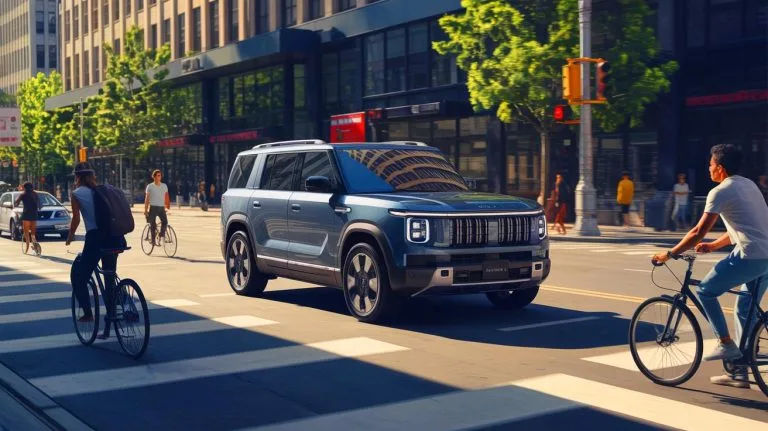| IN A NUTSHELL |
|
In recent years, car manufacturers have invested significant resources into improving vehicle safety and engineering. However, a recent study by the Insurance Institute for Highway Safety (IIHS) suggests that some aspects of vehicle design may have regressed, particularly in terms of driver visibility. This revelation comes amidst rising fatalities for cyclists and pedestrians, contrasting with the decline in car passenger deaths over the last quarter-century. The study sheds light on how newer car models might be contributing to this alarming trend by obstructing drivers’ views, thereby impacting the safety of vulnerable road users.
The Shrinking Near-Car View
The IIHS study highlights a troubling trend: the near-car view for drivers has diminished significantly in newer car models compared to older ones. Researchers found that the viewable area immediately surrounding a vehicle has contracted over time, particularly in SUVs. For instance, a 1997 Honda CR-V allowed drivers to see 68% of the space in a forward half-circle with a 33-foot radius. By contrast, the 2023 model offers a mere 28% visibility in the same area. This dramatic reduction suggests that drivers today have a much harder time spotting cyclists and pedestrians near their vehicles.
The study also examined other popular models, including the Chevrolet Suburban, Jeep Grand Cherokee, and Ford F-150, revealing similar trends. While traditional cars like the Honda Accord and Toyota Camry showed only slight reductions in near-car view, SUVs demonstrated significant shrinkage. The findings suggest that design choices in recent SUV models prioritize other features over critical near-field visibility.
Design Choices Impacting Visibility
The IIHS study attributes the reduced visibility in newer vehicles to several design elements. Higher hoods and larger side mirrors, while improving certain aspects of visibility, contribute to increased blind spots around the front corners of the car. Additionally, wider A-pillars and larger rear-view mirrors, often positioned lower or closer, compound the problem by obstructing the driver’s view of nearby objects. These design choices reflect a compromise in vehicle design priorities, with near-field visibility being sacrificed for other features.
As SUV sales continue to dominate the market, accounting for nearly 60% of new vehicles purchased in the U.S. last year, the implications of these design trends are significant. The study underscores the need for car manufacturers to reconsider design elements that may inadvertently compromise the safety of pedestrians and cyclists. Redesigning vehicles to enhance near-field visibility could be crucial in reversing the trend of rising fatalities among vulnerable road users.
“68 Out of 100”: Subaru Destroys Toyota and Lexus in Massive 300,000 Vehicle Reliability Study
Assessing the Broader Impact
While the IIHS study stops short of conclusively linking reduced visibility to increased fatalities, the findings provide a compelling argument for further investigation. The study’s authors caution against drawing definitive conclusions, noting that the scope of the research is too narrow to establish a direct causal relationship. However, the data aligns with the experiences of many drivers who have noticed a decline in their ability to see nearby objects in newer vehicles.
As the IIHS continues its research, exploring more models and refining its measurement techniques, the automotive industry faces a critical question: How can future vehicle designs balance safety, visibility, and other competing attributes? The study serves as a wake-up call for both manufacturers and regulators to prioritize pedestrian and cyclist safety in the design and testing of new vehicles.
Exploring Solutions for Enhanced Safety
To address the challenges identified in the IIHS study, car manufacturers may need to rethink their approach to vehicle design. Solutions could include redesigning vehicle structures to reduce blind spots, incorporating advanced technologies to assist drivers in detecting nearby obstacles, and implementing stricter regulations on visibility standards. Additionally, educating drivers on the limitations of their vehicles’ visibility and promoting awareness of vulnerable road users could play a vital role in enhancing safety.
The IIHS’s development of a new camera-based method for measuring view-area represents a step forward in understanding visibility issues. By providing accurate and efficient assessments of driver visibility, this tool could aid in the evaluation and improvement of vehicle designs. As the automotive landscape evolves, stakeholders must collaborate to ensure that advancements in technology and design do not come at the expense of safety.
As the automotive industry grapples with the findings of the IIHS study, the question remains: How will manufacturers and regulators respond to the challenge of improving near-field visibility in new vehicles? Addressing this issue could be key to reducing fatalities among cyclists and pedestrians, ultimately fostering safer road environments for all users.
Did you like it? 4.6/5 (22)







Wow, I had no idea modern cars had such huge blind spots. Thanks for shedding light on this! 🚗
Wow, I had no idea modern cars had such big blind spots. Thanks for the eye-opening article! 🚗👀
Are car manufacturers even considering pedestrian safety these days?
Is this just another reason to bring back smaller cars or just a wake-up call for better design?
This explains why I keep bumping into things while parking my new SUV. 😅
Maybe we should all just start driving 1997 Honda CR-Vs again. Seems like they had it figured out! 😂
Why would they make cars less safe for pedestrians just to look cooler?
Great article, but I wonder how these design changes slipped past safety regulations in the first place?
Interesting article! I hope manufacturers take this seriously and make some changes.
I always thought my old car had better visibility. Now I know why!
How do these blind spots compare to those in electric vehicles? Are they any different?
Can’t believe I spent so much money on a car that’s less safe for others. 😤
It’s sad to see safety being compromised for aesthetics. When will manufacturers learn? 😞
So, are there any brands known for better visibility in their vehicles?
The stats are alarming! Has there been any response from automakers yet?
Maybe it’s time to go back to smaller cars? SUVs seem to be the main culprits.